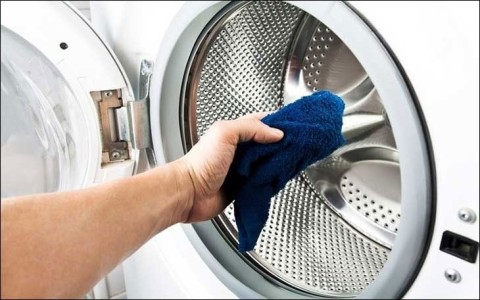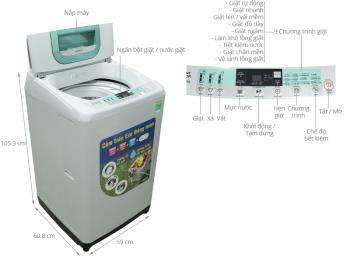How to use the washing machine cleaning mode correctly and effectively

The article below will help you understand how to use the washing machine cleaning mode properly to help remove bacteria and dirt.
A direct drive washing machine is the latest advancement in washing technology, designed to replace the older indirect drive models. But what exactly sets these two types apart? In this article, we at WebTech360 will guide you through the features, advantages, and disadvantages of both types to help you make an informed choice that best suits your family's needs.

Choose to buy direct drive (left) and indirect drive (right)
An indirect drive washing machine operates through a belt system that connects the motor to the drum. This motor converts electrical energy into the rotational motion of the drum via the belt, which serves as a link between the motor and the washer's pulley. An easy analogy is how pedaling a bicycle propels the rear wheel.

The movement is performed via the belt between the motor and the drum
>>> See more: How to Choose the Washing Machine Suitable for Family Needs
A direct drive washing machine integrates the motor, belt, and pulley into a single, compact design directly attached to the washing drum. This minimizes noise and maximizes energy efficiency while delivering outstanding performance. The design allows for increased spin speed, significantly reducing drying time.

The direct drive machine uses Inverter technology to save energy effectively
In summary, both washing machine types have their unique features, advantages, and disadvantages. As technology progresses, direct drive washing machines are becoming increasingly popular, but indirect drive models also offer valuable benefits. Armed with this information, you can choose the washing machine that best serves your family's needs!
The article below will help you understand how to use the washing machine cleaning mode properly to help remove bacteria and dirt.
During the humid season, electronic and refrigeration equipment often malfunction or break down due to high humidity in the air. If you know how to handle humidity in your home, your equipment will avoid the above situations.
Whether or not to use shelves for the washer and dryer or to stack the dryer directly on top of the washing machine is a topic that attracts thousands of comments on a number of forums.
Discover the best washing machine brands such as Hitachi, Candy, Midea, Beko, and Whirlpool with our detailed reviews. WebTech360 helps you choose the best washing machine that suits your needs.
Washer dryers are a common appliance in every Vietnamese family today. So how to use the washer dryer for as long as possible? Let's find out together!
Discover the best washing machine brands such as Hitachi, Candy, Midea, Beko, and Whirlpool with our detailed reviews. WebTech360 helps you choose the best washing machine that suits your needs.
Available in the Vietnamese market since 2001, Darling TV is gradually becoming familiar to users. Discover if Darling TV is good and durable, alongside the top 3 models worth buying.
Deciding whether to buy a Hitachi or Samsung refrigerator is challenging, as both brands are synonymous with quality and luxury.
When running a newly purchased refrigerator, you notice the sides heating up, raising concerns about a potential fault. This article from WebTech360 provides insights into this phenomenon.
Discover why buying a Panasonic refrigerator could be the right choice for you. Learn about its advantages, technologies, and energy efficiency.
Considering a 55 inch or 65 inch TV for a space under 25m²? Explore expert recommendations in this informative article to make the best choice for your room!
Infrared stove is favored by many consumers and is a substitute for traditional gas stoves. However, not everyone uses the infrared stove properly. Here are the common mistakes that you should avoid to use infrared cookers safely and effectively.
Discover effective methods for preserving banh chung and banh tet through proper storage to prevent mold and rancidity. Learn from WebTech360 on how to enjoy these traditional Vietnamese dishes safely!
Explore the differences between direct drive and indirect drive washing machines, their features, advantages, and disadvantages to make an informed decision for your home. WebTech360 provides insights to help choose the right washing machine for your family needs.
Discover the advantages of soft freezing technology found in modern refrigerators, enhancing food preservation and convenience. Learn how this technology ensures your family
Discover the revolutionary Punch + 3 technology in LG washing machines that increases cleaning efficiency and reduces tangles for a better laundry experience.
Explore the features and benefits of Hitachi and LG refrigerators to make an informed choice. Are Hitachi or LG refrigerators the best fit for you?
Discover the differences between Electrolux and Hitachi refrigerators including features, prices, and technology to make an informed choice.
Discover how to distinguish real and fake Bose 301 speakers effectively with our comprehensive guide because of the brand
Comparing Hitachi and Panasonic washing machines to help you choose the best option for your needs.


















Thùy Linh -
I’m so glad I found your article! It answered so many of my questions regarding efficiency.
Huyền Lizzie -
Your article has made me reconsider my current washing machine brand. I might switch to a direct drive one
Mèo con -
Just bought a direct drive. It’s so quiet! I can do laundry at night without disturbing anyone
Linh mèo -
Great post! I find that direct drives are more energy-efficient, which is a big plus for me
Duy Sinh 6789 -
I once had a direct drive machine and I adored it! But it broke down way too soon for my liking
Thùy Linh -
Great article! It's about time someone did a comparison between these two types. Has really helped me
Hương Đà Nẵng -
I’ve always thought direct drive machines were better due to less noise, but after reading this, I'm considering indirect ones now. Great insights
Phúc IT -
Has anyone else tried hybrid options? I’ve been hearing good things about those as well
Mèo con -
Personally, I prefer indirect drive washing machines. They seem to be more reliable! Anyone else feel the same
Hương Đà Nẵng -
If anyone has tips on maintenance for these machines, please share! I want them to last!
Hương KT -
Indirect drive machines typically have a longer lifespan, right? That’s what I've heard from friends. Any experiences to share
Quang vn -
This was very informative! Now I feel more confident about making a purchase.
Huyền Lizzie -
I love my direct drive washing machine! It gets the clothes so clean and I don’t have to worry about belts breaking.
Nguyễn Văn An -
After using both types, I think it really comes down to personal preference and what you value most in a machine
Mèo con -
Is it true that direct drive machines have less vibration? I really hate when my washing machine shakes!
Thùy Linh -
This article really helped me understand the difference between direct and indirect drive washing machines. I was leaning towards the direct drive option but now I have a clearer view
Nguyễn Thế Anh -
Does anyone have experience with mixed load washing? I heard indirect drives are better for that
Phúc IT -
Just switched to a direct drive washing machine and I can't believe how quiet it is compared to my old one. Definitely a game changer
Phúc IT -
I think both types have their pros and cons. I guess it depends on what you need most from a washing machine
Mèo con -
I appreciate the detailed pros and cons you've provided. It’s always nice to see both sides
Hương KT -
Thanks for this post! You’ve definitely got me thinking about making an upgrade soon.
Quang vn -
I had no idea there was so much to consider when buying a washing machine. Thanks for breaking down the pros and cons
Duy Sinh 6789 -
Can someone explain if the maintenance costs differ between the two types? I want to make an informed decision.
Thùy Linh -
Wow, I never knew the differences were this significant! This will definitely influence my next purchase
Quang vn -
Thanks for sharing! I’m still on the fence, but this info helps steer me closer to a decision.
Nguyễn Văn An -
I often hear mixed opinions on direct drives. It's nice to have an unbiased viewpoint
Huyền Lizzie -
I don't really mind the noise from an indirect drive machine, but I see why many prefer direct drives
Phúc IT -
I had a direct drive machine for years - when it finally broke, I had a hard time deciding what to buy next
Duy Sinh 6789 -
Any recommendations for brands? I want something durable and efficient!
Mèo con -
I always thought indirect drives were outdated, but after reading this, I see their benefits too